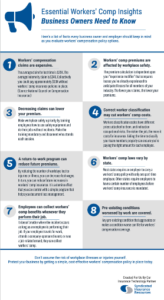Talking to your employer clients about workers’ comp insurance can seem pretty cut and dry. It is a fact that all small business owners need workers’ comp. Yet, there is so much more to it than your small business owner clients probably know.
Consumers and agents alike realize the basics about workers’ comp are pretty easy to understand. The bottom line is that every employer is responsible for providing a safe work environment, and liable for any occupational injuries.
Workers’ Comp Insurance policies can offer coverage for medical expenses, replacement wages, disability benefits, and even death benefits.
But as an independent insurance agent, you know there is much more information your employer clients need to know.
When you take the time share insights beyond basic understanding, you are providing a valuable service while connecting with your customers. Educating employer clients helps you stand out and gives you a leg up on your competition.
To help you quickly showcase your expertise, we’ve collected a list of Workers’ Comp Facts you can share with prospects. You can read the tips here. But you can also download this sheet to print or email it to your clients. You can even place it on your website.
Share these workers’ comp educational tips with prospective clients whenever you’re going to discuss their workers’ comp needs. Let clients know that your knowledge and expertise is part of the additional value they get when they use your independent insurance agency.
Essential Workers’ Comp Insights Business Owners Need to Know
Here’s a list of facts every business owner and employer should keep in mind as you evaluate workers’ compensation policy options.
Workers’ compensation claims are expensive. The average claim for lost time is $29K. The average indemnity claim is $24K. Collectively you could pay approximately $53K without workers’ comp insurance policies in place. (Source: National Council on Compensation Insurance.)
Workers’ Comp premiums are affected by workplace safety. The premium calculation is dependent upon your “experience modifier” that compares losses you’ve already experienced to anticipated losses for all members of your industry. The fewer your claims, the lower your premiums.
Decreasing claims can lower your premium. Make workplace safety a priority by training employees how to use safety equipment and do their jobs without incidents. Make the training mandatory and document who attends each session.
Correct worker classification may cut workers’ comp costs. Workers classification codes have different prices attached to them, and indication occupational risks. The riskier the job, the more it costs for insurance. Taking the time to classify your team members properly can ensure you’re paying the right amount for each employee.
A return-to-work program can reduce future premiums. By reducing the number of workdays lost to injuries or illness, you can decrease lost wages. In turn, you can reduce future increases in workers’ comp insurance. It is a domino effect that you can control with a simple program that helps you document loss management.
Workers’ comp laws vary by state. Most states require an employer to carry a workers’ comp policy with only one part-time employee. Other states require employers to have a certain number of employees before workers’ comp insurance is mandated.
Employees can collect workers’ comp benefits whenever they perform their job. It doesn’t matter where the incident occurs as long as an employee is performing their job. If your employee travels for work, attends a company-sponsored event, or runs a job-related errand, they can collect workers’ comp.
Pre-existing conditions worsened by work are covered. Any pre-existing condition that aggravates or makes a condition worse can file for workers’ compensation coverage.
Don’t assume the risk of workplace illnesses or injuries yourself. Protect your business by getting a simple, cost-effective workers’ compensation policy in place today.


